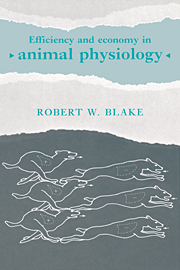Book contents
- Frontmatter
- Contents
- List of contributors
- Preface
- 1 Efficiency, effectiveness, perfection, optimization: their use in understanding vertebrate evolution
- 2 On the efficiency of energy transformations in cells and animals
- 3 Adapting skeletal muscle to be efficient
- 4 Efficiency and other criteria for evaluating the quality of structural biomaterials
- 5 Efficiency and optimization in the design of skeletal support systems
- 6 Efficiency in aquatic locomotion: limitations from single cells to animals
- 7 The concepts of efficiency and economy in land locomotion
- 8 Respiration in air breathing vertebrates: optimization and efficiency in design and function
- 9 Cardiac energetics and the design of vertebrate arterial systems
- 10 An evolutionary perspective on the concept of efficiency: how does function evolve?
- Index
7 - The concepts of efficiency and economy in land locomotion
Published online by Cambridge University Press: 03 October 2009
- Frontmatter
- Contents
- List of contributors
- Preface
- 1 Efficiency, effectiveness, perfection, optimization: their use in understanding vertebrate evolution
- 2 On the efficiency of energy transformations in cells and animals
- 3 Adapting skeletal muscle to be efficient
- 4 Efficiency and other criteria for evaluating the quality of structural biomaterials
- 5 Efficiency and optimization in the design of skeletal support systems
- 6 Efficiency in aquatic locomotion: limitations from single cells to animals
- 7 The concepts of efficiency and economy in land locomotion
- 8 Respiration in air breathing vertebrates: optimization and efficiency in design and function
- 9 Cardiac energetics and the design of vertebrate arterial systems
- 10 An evolutionary perspective on the concept of efficiency: how does function evolve?
- Index
Summary
INTRODUCTION
Is the concept of efficiency in terrestrial locomotion useful when applied at the level of the whole animal? Can measures of efficiency aid in revealing the consequences of variation in morphology and physiology that relate to locomotion on land? Can these measures quantify the effect of variation in leg number (two in humans to over 600 in a millipede), leg length and orientation, stepping pattern (metachronal waves gaits, trotting versus hopping), muscle type, musculo-skeletal arrangement (exo- versus endoskeletons), body shape (long in centipedes and millipedes versus round in some crabs), and locomotor style (forwards versus sideways travel in crabs)? Can measures of efficiency provide useful information about the mechanistic, ecological and evolutionary bases of how animals of diverse body form move? Most lay people, as well as researchers, would probably answer yes to each question. Many functional morphologists, physiologists and biomechanists believe they can recognize efficient terrestrial locomotion. Unfortunately, when our hypotheses are tested, the results are often ambiguous. Whether or not our hypotheses are based on sound principles of physics or physiology seems to make little difference. Awkward marathon runners win gold medals; athletes ranked as inefficient expend less energy than more graceful runners (Cavagna and Kram, 1985); some mammals with large limbs use no more energy than those that evolved more ‘efficient’ tapered limbs (Taylor et al., 1974); and animals, such as a centipede, that ‘waste’ motion as they laterally undulate actually require somewhat less energy to travel a given distance than other animals of the same mass (Full, 1989).
WHAT IS THE DEFINITION OF EFFICIENCY?
How can we resolve this apparent mismatch between reasonable hypotheses and evidence? There are at least two reasons for the mismatch.
- Type
- Chapter
- Information
- Efficiency and Economy in Animal Physiology , pp. 97 - 132Publisher: Cambridge University PressPrint publication year: 1992
- 3
- Cited by



